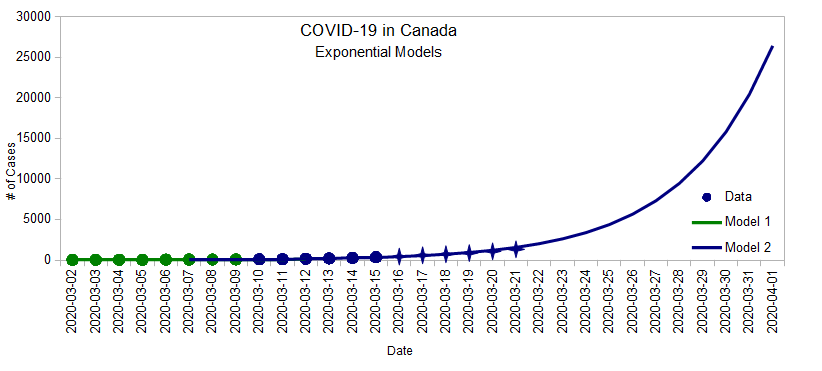This is an old revision of the document!
Table of Contents
COVID-19 Spread (Part II)
- I'm not an epidemiologist, doctor, or any kind of expert on the subject. I just look at the numbers.
In Part I, I built an exponential model using data between March 2 and March 15, then continued to add daily numbers to see how that model tracked:
Initially, the number of cases doubled every 2.7 days, predicting almost 1600 cases by the end of Saturday, but since Thursday, the rate of infection seems to have slowed down a bit and we got about 240 cases less than predicted. This deviation from the exponential model is what I'm exploring here.
Growth Factor
There's a ratio involving three data points that's useful to track how “fast” the exponential grows. It's easier to explain with an example, so suppose we had three days like this:
| Day | # of Cases | New Cases | Growth Factor |
|---|---|---|---|
| Day1 | 100 | ||
| Day2 | 110 | 10 | |
| Day3 | 130 | 20 | 2 |
To calculate the growth factor:
- The first step is to calculate the number of new cases from one day to the next.
- Then, we take the ratio between the number of new cases (20 ÷ 10 = 2)
- If the growth factor is above 1, the number of new cases is itself increasing, which means we are still in the exponential phase.
- If the growth factor is 1, then the number of cases is growing at a constant rate. This is the middle of the Logistic Curve (more on that soon).
- If the growth factor is less than 1, then the infection rate is levelling off.
Here are the number of cases in Canada with the calculated growth factors:
| Date | # of Cases | New Cases | Growth Factor |
|---|---|---|---|
| 2020-03-01 | ? | ||
| 2020-03-02 | 27 | ||
| 2020-03-03 | 27 | 0 | |
| 2020-03-04 | 33 | 6 | |
| 2020-03-05 | 37 | 4 | 0.67 |
| 2020-03-06 | 48 | 11 | 2.75 |
| 2020-03-07 | 60 | 12 | 1.09 |
| 2020-03-08 | 64 | 4 | 0.33 |
| 2020-03-09 | 77 | 14 | 3.25 |
| 2020-03-10 | 95 | 18 | 1.38 |
| 2020-03-11 | 117 | 22 | 1.22 |
| 2020-03-12 | 157 | 40 | 1.82 |
| 2020-03-13 | 201 | 44 | 1.10 |
| 2020-03-14 | 254 | 53 | 1.20 |
| 2020-03-15 | 342 | 88 | 1.66 |
| Date | # of Cases | New Cases | Growth Factor |
|---|---|---|---|
| 2020-03-16 | 441 | 99 | 1.33 |
| 2020-03-17 | 596 | 155 | 1.57 |
| 2020-03-18 | 727 | 131 | 0.85 |
| 2020-03-19 | 873 | 146 | 1.11 |
| 2020-03-20 | 1087 | 214 | 1.47 |
| 2020-03-21 | 1331 | 244 | 1.14 |
| 2020-03-22 | 14721) | 141 | 0.58 |
| 2020-03-23 | |||
| 2020-03-24 | |||
| 2020-03-25 | |||
| 2020-03-26 | |||
| 2020-03-27 | |||
| 2020-03-28 | |||
| 2020-03-29 | |||
| 2020-03-30 |
There's a lot of variation in the growth factor because real life is messy. It's also worth keeping in mind that the number of cases are contingent on how much testing we do. It's easy to imagine that testing labs are lagging a few days behind and that they'll sometimes be able to report more results one day and less the next. We don't have an accurate picture of the world here so it's hard to make any kind of hard predictions. Never-the-less, if we plot the growth factor on a graph, we can see a bit of a pattern:

Overall, the growth factor seems to stay above 1 (exponential phase), but it looks like we might be on track to reach 1 by the end of the month (end of exponential phase). If that's the case, and if we continue to implement measures to slow the down the spread, then we'll be in a better position to estimate the final outcome by the end of the month. Here's why.
The Logistic Curve
In Part I, we saw that very different Logistic Curves can fit the current data, and that there's really no way of knowing which path we're on yet. Here they are again:
- Model 3 is the very best case scenario where the total number will be double of what it is today. This assumes that the growth factor reached 1 yesterday (March 21), which it hasn't.
- Model 4 is a very likely scenario where the total number reaches 20,000 and the growth factor reaches 1 on April 1st. This is not a worst case scenario. Things could be much worse (look at Italy).
- Model 5 is an optimistic scenario where the total number reaches 12,000 and the growth factor reaches 1 on March 30st.
The thing to know about Logistic Curves is that in the middle (where number of cases is half of the total), the growth factor is 1. Once we reach that point, we'll be able to get a better estimate of where we'll end up. Until then, things are still very much in the air.
I'll wait until the end of March 23 to re-calculate the Growth Factor best fit line.




